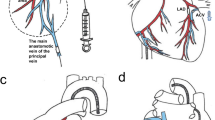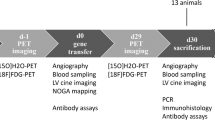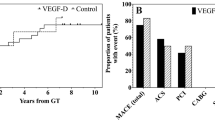Abstract
The aim of this study was to determine the effects of direct intramyocardial pVEGF165 gene transfer on regional myocardial blood flow in a porcine model of chronic myocardial ischaemia. Pigs underwent placement of an ameroid constrictor around the left circumflex coronary artery. After 3 weeks, animals received direct intramyocardial injections of pVEGF165 (20 × 50 μl at 1 μg/μl, n=11) or a plasmid vector encoding chloramphenicol acetyltransferase (20 × 50 μl at 1 μg/μl, n=11) into a specified target area (TA) of the left lateral wall. At 3 weeks after gene transfer, animals underwent final evaluation including a systematic assessment of regional myocardial blood flow (MBF) under resting and stress conditions. In all, 20 animals (10 per group) reached final studies. There was no change in mean arterial blood pressure or Rentrop collateral score from gene delivery to final studies in either group, nor were there differences between study groups. MBF was significantly higher in the areas adjacent to the TA in the VEGF group under resting (P<0.001) and stress conditions (P<0.05). In addition, pVEGF165 gene transfer abolished flow differences between the adjacent areas and the septum. MBF was not different between study groups in the TA, the anterior wall, or the septum. In conclusion, direct intramyocardial pVEGF165 gene transfer significantly improves myocardial blood flow. However, this effect is limited to the myocardial segments adjacent to the area of gene delivery. These data, therefore, demonstrate a spatial ‘delivery–efficacy’ mismatch with implications for myocardial gene delivery sites and detection of treatment effects in vivo.
This is a preview of subscription content, access via your institution
Access options
Subscribe to this journal
Receive 12 print issues and online access
$259.00 per year
only $21.58 per issue
Buy this article
- Purchase on Springer Link
- Instant access to full article PDF
Prices may be subject to local taxes which are calculated during checkout






Similar content being viewed by others
References
Mukherjee D et al. Direct myocardial revascularisation and angiogenesis – how many patients might be eligible? Am J Cardiol 1999; 84: 598–600.
Simons M et al. Clinical trials in coronary angiogenesis: issues, problems, consensus. An expert panel summary. Circulation 2000; 102: e73–e86.
Losordo DW et al. Gene therapy for myocardial angiogenesis: initial clinical results with direct myocardial injection of phVEGF165 as sole therapy for myocardial ischemia. Circulation 1998; 98: 2800–2804.
Rosengart TK et al. Angiogenesis gene therapy: phase I assessment of direct intramyocardial administration of an adenovirus vector expressing VEGF121 cDNA to individuals with clinically significant severe coronary artery disease. Circulation 1999; 100: 468–474.
Tio R et al. Intramyocardial gene therapy with naked DNA encoding vascular endothelial growth factor improves collateral flow to ischemic myocardium. Hum Gene Ther 1999; 10: 2953–2960.
Mack CA et al. Biological bypass with use of adenovirus-mediated gene transfer of the complementary deoxyribonucleic acid for vascular endothelial growth factor 121 improves myocardial perfusion and function in the ischemic porcine heart. J Thorac Cardiovasc Surg 1998; 115: 168–177.
Lee LY et al. Focal angiogen therapy using intramyocardial delivery of an adenovirus vector coding for vascular endothelial growth factor 121. Ann Thorac Surg 2000; 69: 14–24.
White FC, Carroll SM, Magnet A, Bloor CM . Coronary collateral development in swine after coronary artery occlusion. Circ Res 1992; 71: 1490–1500.
Fuchs S et al. Lack of correlation between angiographic grading of collateral and myocardial perfusion and function: implications for the assessment of angiogenic response. Cor Art Dis 2001; 12: 173–178.
Sato K et al. Efficacy of intracoronary or intravenous VEGF165 in a pig model of chronic myocardial ischemia. J Am Coll Cardiol 2001; 37: 616–623.
Lopez JJ et al. VEGF administration in chronic myocardial ischemia in pigs. Cardiovasc Res 1998; 40: 272–281.
Chu VF et al. Angiogenesis using transmyocardial revascularization: comparison of laser versus mechanical pnctures. Ann Thorac Surg 1999; 68: 301–307.
Saito T et al. Nitric oxide system in needle-induced transmyocardial revascularization. Ann Thorac Surg 2001; 72: 129–136.
Pearlman JD, Laham RJ, Simons M . Coronary angiogenesis: detection in vivo with MR imaging sensitive to collateral neocirculation- preliminary study in pigs. Radiology 2000; 214: 801–807.
Laham RJ et al. Intracoronary basic fibroblast growth factor (FGF-2) in patients with severe ischemic heart disease: results of a phase I open-label dose escalation study. J Am Coll Cardiol 2000; 36: 2132–2139.
Udelson JE et al. Therapeutic angiogenesis with recombinant fibroblast growth factor-2 improves stress and rest myocardial perfusion abnormalities in patients with severe symptomatic coronary artery disease. Circulation 2000; 102: 1605–1610.
Peterson GL . A simplification of the protein assay method of Lowry et al. Which is more generally applicable? Anal Biochem 1977; 83: 346–356.
Hughes GC et al. Translational physiology: porcine models of human coronary artery disease: implications for preclinical trials of therapeutic angiogenesis. J Appl Physiol 2003; 94: 1689–1701.
Cohen M, Rentrop KP . Limitation of myocardial ischemia by collateral circulation during sudden controlled coronary artery occlusion in human subjects: a prospective study. Circulation 1986; 74: 469–476.
Harada K et al. Vascular endothelial growth factor administration in chronic myocardial ischemia. Am J Physiol 1996; 270: H1791–H1802.
Reinhardt CP et al. Stable labeled microspheres to measure perfusion: validation of a neutron activation assay technique. Am J Physiol Heart Circ Physiol 2001; 280: H108–H116.
Lee ER et al. Detailed analysis of structures and formulations of cationic lipids for efficient gene transfer. Hum Gene Ther 1996; 7: 1701–1717.
Acknowledgements
This work was supported by the British Heart Foundation (Grant No. 7704), the Royal Brompton Hospital Trust, Medicor Foundation (AHG), a Fellowship from the German Cardiac Society (PWR) and a Wellcome Trust Senior Clinical Fellowship (EWFWA). We gratefully acknowledge Dr Yoshikazu Yonemitsu and Dr Kazunori Nakagawa for the gift of the human VEGF165 cDNA, Dr Roger J Laham for valuable discussions, Professor Christof Huth, Dr Dirk Mahnkopf, Antje Mittag, and Uwe Rätzel for expert technical assistance during the studies, Robin Cassady for preparation of the plasmids and Tracy Higgins for her organisational support during the project.
Author information
Authors and Affiliations
Rights and permissions
About this article
Cite this article
Radke, P., Heinl-Green, A., Frass, O. et al. Effects of intramyocardial pVEGF165 delivery on regional myocardial blood flow: evidence for a spatial ‘delivery–efficacy’ mismatch. Gene Ther 11, 1249–1255 (2004). https://doi.org/10.1038/sj.gt.3302296
Received:
Accepted:
Published:
Issue Date:
DOI: https://doi.org/10.1038/sj.gt.3302296
Keywords
This article is cited by
-
Vascular endothelial growth factor in heart failure
Nature Reviews Cardiology (2013)
-
Cardiac gene therapy in large animals: bridge from bench to bedside
Gene Therapy (2012)
-
SDF-1 in myocardial repair
Gene Therapy (2012)



